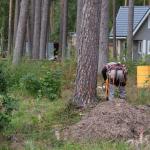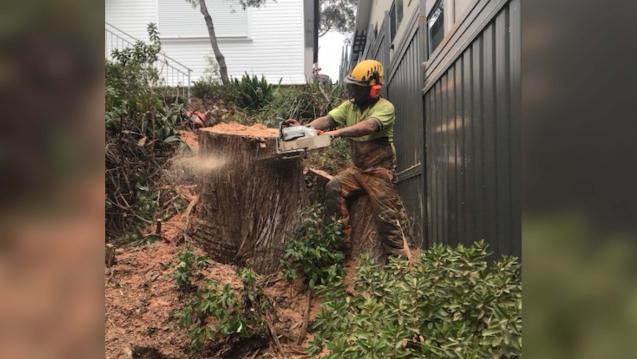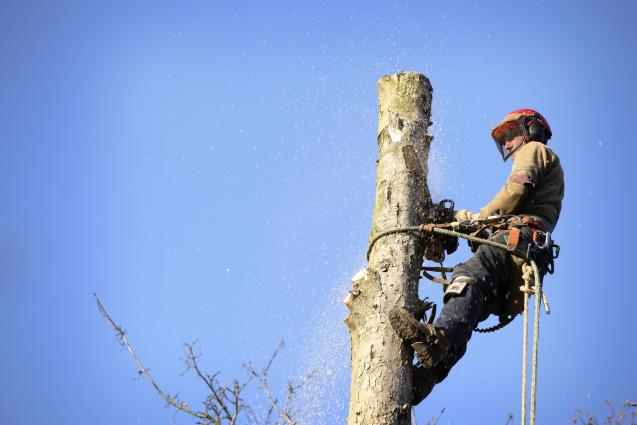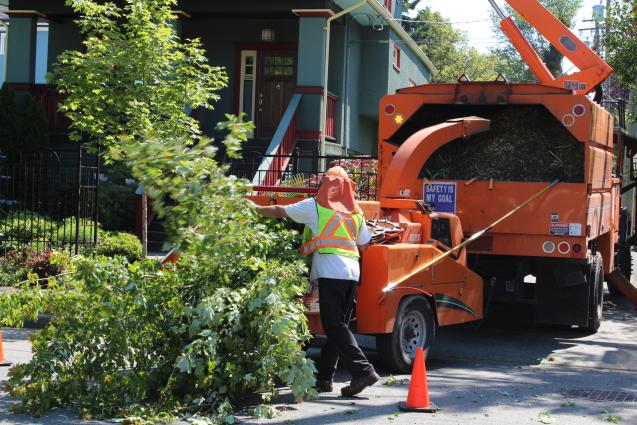
A Comprehensive Guide on the Essential Precautions for Safe Tree Removal
By Wolf Trees and Gardens|April 22, 2024
Hierarchy among nature is vast and varied, however, trees unmistakably stand tall as silent custodians of the environment. Trees are invaluable assets, providing shade, oxygen, and often, a quiet sense of serenity. Despite their inherent benefits, there are circumstances where tree removal becomes necessary and invaluable.
Tree removal essentially involves cutting down, uprooting, and full eradication of trees within a specific area. This seemingly simple operation possesses complex intricacies and inherent hazards, necessitating the strict adoption of optimal safety measures. While the process might appear reasonably uncomplicated, it's all but a walk in the park - tree removal involves a lot more than swinging an axe or operating a chainsaw.
Understanding When Tree Removal is Necessary
Understanding when is tree removal necessary, however, it is not always an easy task. Proper knowledge and awareness of the signs that indicate the necessity for tree removal are crucial. Signs that a tree might need to be removed include visible disease symptoms such as unseasonal leaf discoloration or abnormal fungus growth.
Furthermore, structural damages to the trunk, significant branch dieback, and shallow root structures that threaten tree stability might also classify a tree for removal. Another important flag is disproportionate or uncontrolled tree growth affecting nearby structures and power lines.
Various seasonal effects can also compromise tree stability. For instance, winter frost can make trees brittle, leading to potential breakage, while consistent summer droughts can cause severe hydration-stress, weakening the tree. Thus, a year-round vigilance and regular monitoring of tree health and stability are strongly recommended.
Ignoring a compromised, dying or dead tree comes fraught with considerable risks. For instance, falling branches might be a significant cause for undue injury or considerable property damage. Extreme weather conditions like storms or gales can result in completely uprooted trees, which can be a grave safety concern.
Choosing the Right Tree Removal Professionals
Given the potential risk magnitude, involving a professional tree service becomes more of a necessary precautionary measure than an optional luxury. Tree specialists or 'Arborists', with their advanced training and specific diagnostic tools, are much more competent in spotting potential issues and recommending the best course of action.
The consideration to engage a professional for tree removal might seem like a significant initial overhead cost for some. Many homeowners consider taking up the task independently to save on outlay. Yet, the potential benefits of incorporating expert services in terms of safety and efficiency significantly outweigh the initial cost.
Selecting a tree removal service requires careful thought and consideration. It's worth considering various factors such as the service's years of active experience, qualifications of the personnel, and their overall reputation in the market. It is crucial to ensure that the company possesses the required certification and insurance to cover unforeseen accidents or damages that may potentially occur during tree removal operations.
The Role of Proper Equipment in Safe Tree Removal
Notably, making certain that the service employs the essential specialised equipment also plays a vital role in the tree removal process. Specialist tools and equipment such as chainsaws, ropes, axes, stump grinders, and heavy-duty loppers should be adequately maintained and readily available in the professional's toolkit.
Additionally, the team undertaking the operation must use safety gear like helmets, harnesses, gloves and protective clothing to minimise accidental injuries during the operation. Using faulty, malfunctioning, or inappropriate equipment poses a high risk and can result in disastrous outcomes. By ensuring that your chosen service provider carries and utilises the necessary equipment, you help ensure a safe and efficient job.
Understanding the Tree Removal Process
Understanding the tree removal process helps to have a sense of what to expect when engaging a professional service. Fundamentally, the process involves four primary steps; environmental evaluation, removal planning, tree felling, and post-removal checks.
Professionals generally conduct a comprehensive assessment of the area surrounding the tree. By identifying potential obstacles and hazards ahead of time, they can plan their tree removal strategy accordingly. Assuring that this necessary standard is rigorously followed throughout checks the boxes for the provider’s compliance to the set safety standards.
Legal and Environmental Considerations
Before removing a tree on your property, it's crucial to understand the legal and environmental implications. Local councils have varying regulations, often including Tree Preservation Orders (TPOs) and Local Environment Plans (LEPs) that dictate which trees require permits for removal. Failing to obtain the proper permits can result in hefty fines.
Tree removal can also significantly impact the environment. Trees provide habitat for local fauna, and their root systems help maintain healthy soil composition. Removing a tree can disrupt animal life and contribute to soil erosion. Therefore, whenever possible, explore alternatives to removal. If removal is unavoidable, consider replanting native species or implementing compensatory measures like habitat boxes for displaced wildlife.
In conclusion, it is beyond crucial to recognise that while tree removal can indeed be necessary, it also comes with its share of inherent risks and responsibilities, ethical, legal, and otherwise. So, if you're dealing with a potentially hazardous tree close to your home, a tree that's ill and poses a danger, or simply wanting to understand the process for future requirements, having an in-depth understanding of the protocols involved is the first step in ensuring a safe and hassle-free tree removal experience. This comprehensive knowledge of necessary precautions and safeties, as well as the specific local regulations, further inform you to tackle such a complex operation with confidence and poise.
Tree removal essentially involves cutting down, uprooting, and full eradication of trees within a specific area. This seemingly simple operation possesses complex intricacies and inherent hazards, necessitating the strict adoption of optimal safety measures. While the process might appear reasonably uncomplicated, it's all but a walk in the park - tree removal involves a lot more than swinging an axe or operating a chainsaw.
Understanding When Tree Removal is Necessary
Understanding when is tree removal necessary, however, it is not always an easy task. Proper knowledge and awareness of the signs that indicate the necessity for tree removal are crucial. Signs that a tree might need to be removed include visible disease symptoms such as unseasonal leaf discoloration or abnormal fungus growth.
Furthermore, structural damages to the trunk, significant branch dieback, and shallow root structures that threaten tree stability might also classify a tree for removal. Another important flag is disproportionate or uncontrolled tree growth affecting nearby structures and power lines.
Various seasonal effects can also compromise tree stability. For instance, winter frost can make trees brittle, leading to potential breakage, while consistent summer droughts can cause severe hydration-stress, weakening the tree. Thus, a year-round vigilance and regular monitoring of tree health and stability are strongly recommended.
Ignoring a compromised, dying or dead tree comes fraught with considerable risks. For instance, falling branches might be a significant cause for undue injury or considerable property damage. Extreme weather conditions like storms or gales can result in completely uprooted trees, which can be a grave safety concern.
Choosing the Right Tree Removal Professionals
Given the potential risk magnitude, involving a professional tree service becomes more of a necessary precautionary measure than an optional luxury. Tree specialists or 'Arborists', with their advanced training and specific diagnostic tools, are much more competent in spotting potential issues and recommending the best course of action.
The consideration to engage a professional for tree removal might seem like a significant initial overhead cost for some. Many homeowners consider taking up the task independently to save on outlay. Yet, the potential benefits of incorporating expert services in terms of safety and efficiency significantly outweigh the initial cost.
Selecting a tree removal service requires careful thought and consideration. It's worth considering various factors such as the service's years of active experience, qualifications of the personnel, and their overall reputation in the market. It is crucial to ensure that the company possesses the required certification and insurance to cover unforeseen accidents or damages that may potentially occur during tree removal operations.
The Role of Proper Equipment in Safe Tree Removal
Notably, making certain that the service employs the essential specialised equipment also plays a vital role in the tree removal process. Specialist tools and equipment such as chainsaws, ropes, axes, stump grinders, and heavy-duty loppers should be adequately maintained and readily available in the professional's toolkit.
Additionally, the team undertaking the operation must use safety gear like helmets, harnesses, gloves and protective clothing to minimise accidental injuries during the operation. Using faulty, malfunctioning, or inappropriate equipment poses a high risk and can result in disastrous outcomes. By ensuring that your chosen service provider carries and utilises the necessary equipment, you help ensure a safe and efficient job.
Understanding the Tree Removal Process
Understanding the tree removal process helps to have a sense of what to expect when engaging a professional service. Fundamentally, the process involves four primary steps; environmental evaluation, removal planning, tree felling, and post-removal checks.
Professionals generally conduct a comprehensive assessment of the area surrounding the tree. By identifying potential obstacles and hazards ahead of time, they can plan their tree removal strategy accordingly. Assuring that this necessary standard is rigorously followed throughout checks the boxes for the provider’s compliance to the set safety standards.
Legal and Environmental Considerations
Before removing a tree on your property, it's crucial to understand the legal and environmental implications. Local councils have varying regulations, often including Tree Preservation Orders (TPOs) and Local Environment Plans (LEPs) that dictate which trees require permits for removal. Failing to obtain the proper permits can result in hefty fines.
Tree removal can also significantly impact the environment. Trees provide habitat for local fauna, and their root systems help maintain healthy soil composition. Removing a tree can disrupt animal life and contribute to soil erosion. Therefore, whenever possible, explore alternatives to removal. If removal is unavoidable, consider replanting native species or implementing compensatory measures like habitat boxes for displaced wildlife.
In conclusion, it is beyond crucial to recognise that while tree removal can indeed be necessary, it also comes with its share of inherent risks and responsibilities, ethical, legal, and otherwise. So, if you're dealing with a potentially hazardous tree close to your home, a tree that's ill and poses a danger, or simply wanting to understand the process for future requirements, having an in-depth understanding of the protocols involved is the first step in ensuring a safe and hassle-free tree removal experience. This comprehensive knowledge of necessary precautions and safeties, as well as the specific local regulations, further inform you to tackle such a complex operation with confidence and poise.



